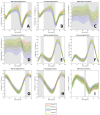Biomechanical analysis of barefoot walking and three different sports footwear in children aged between 4 and 6 years old
- PMID: 37669303
- PMCID: PMC10479898
- DOI: 10.1371/journal.pone.0291056
Biomechanical analysis of barefoot walking and three different sports footwear in children aged between 4 and 6 years old
Abstract
The technological transformation and advertising utilized in the footwear industry significantly impact purchasing decisions. The gait properties, barefoot and with shoes, change depending on the footwear structure. The aim of this work is the biomechanical analysis of walking barefoot and with different sports shoes in a controlled group of 12 children between 4 and 6 years old. Kinematic and spatiotemporal variables were analyzed using a BTS motion capture analysis system with the Helen Hayes protocol. Previously, a survey was carried out with 262 families with children between 4 and 6 years old to justify the choice of footwear for this study. No significant differences were found between any of the measured conditions. The kinematic results showed significant differences in the ankle (right sagittal plane p = 0.04, left p < 0.01; right frontal plane p < 0.01, left p < 0.01), knee (right and left sagittal plane p < 0.01) and hip (right sagittal plane p < 0.01, left p = 0.04; right frontal plane p = 0.03). Additionally, the post hoc analysis revealed significant differences between barefoot gait and different footwear. The footwear used for this study and each one's various characteristics are not preponderant in the spatiotemporal and kinematic parameters of the children's gait. Thus, the footwear purchase may be conditioned by its design or composition and other properties may not be relevant.
Copyright: © 2023 López et al. This is an open access article distributed under the terms of the Creative Commons Attribution License, which permits unrestricted use, distribution, and reproduction in any medium, provided the original author and source are credited.
Conflict of interest statement
The authors have declared that no competing interests exist.
Figures
References
-
- Staheli LT. Shoes for children: a review. Pediatrics. 1991;88: 371–375. - PubMed
-
- Plazas ER, Guerrero EEZ. Factores que inciden en la compra de zapatos, Rev Colomb Market. 2007;6: 7–14.
-
- Abellán LD. Morfología del pie infantil. Evolución y ejercicio físico. Ph.D. Dissertation. Universidad de Castilla- La Mancha. 2016. https://ruidera.uclm.es/xmlui/bitstream/handle/10578/8573/TESIS%20Delgad...
Publication types
MeSH terms
Associated data
LinkOut - more resources
Full Text Sources



